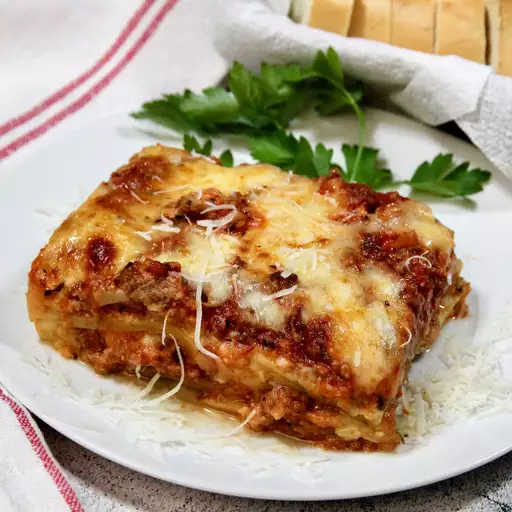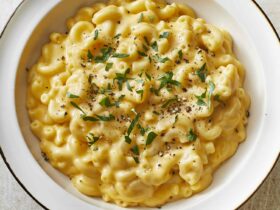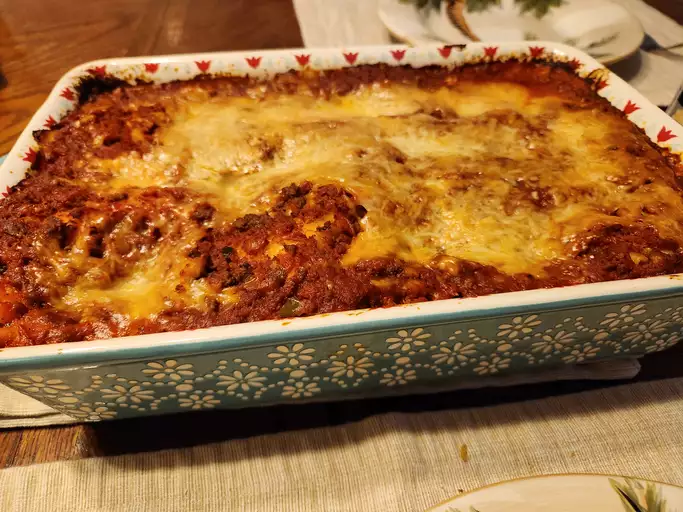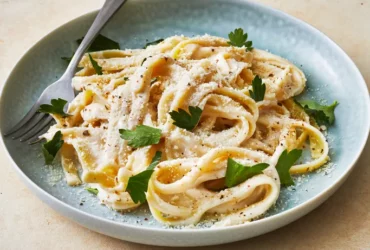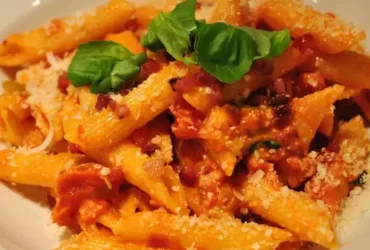Ingredients
Cooking Essentials
The key to making a delicious homemade lasagna recipe lies not only in the quality of the ingredients used but also in having the right cooking essentials at hand.
Ingredients
Breadcrumbs
Freshly made or store-bought, breadcrumbs are essential for creating a crunchy topping for your lasagna. You can use plain white bread or a mixture of white and whole wheat bread.
Tomato Sauce
Homemade tomato sauce is a game-changer in the world of pasta dishes. It’s made with crushed tomatoes, garlic, olive oil, salt, and herbs like basil and oregano. You can also use store-bought sauce as a substitute if you’re short on time.
Ground Beef or Sausage
Choose your preferred ground meat for added flavor to the lasagna. Be sure to cook it thoroughly before mixing it with tomato sauce and cheese.
Mozzarella Cheese
The star of the show, mozzarella cheese adds creaminess and texture to every bite. Fresh or low-moisture mozzarella works best for melting purposes.
Parmesan Cheese
A sprinkle of parmesan adds a salty, nutty flavor that complements the sweetness of tomatoes perfectly. Use grated parmesan for better distribution throughout the dish.
Lasagna Noodles
Choose either flat lasagna noodles or the traditional wide ones to create your masterpiece.
Cooking Essentials
Pasta Maker or Stand Mixer with Pasta Attachment
A dedicated pasta maker helps you roll out and shape lasagna noodles to the perfect thickness, while a stand mixer can make mixing and kneading dough much easier.
9×13-Inch Baking Dish
A non-stick baking dish ensures your lasagna doesn’t stick to it during cooking, making cleanup effortless.
Oven Thermometer
An essential tool for ensuring precise oven temperature control. This helps prevent overcooking or undercooking the lasagna.
By investing in these ingredients and cooking essentials, you’ll be well on your way to crafting a homemade lasagna that’s both authentic Italian-style and tailored to your taste preferences!
Olive Oil
Olive oil is an essential ingredient in many Italian dishes, including homemade lasagna recipes. It’s often used as a finishing touch to add flavor and moisture to the final product.
When selecting olive oil for your lasagna recipe, it’s crucial to choose a high-quality oil that complements the other ingredients. Look for an extra-virgin olive oil (EVOO) with a mild or fruity flavor profile, as it won’t overpower the taste of the other ingredients.
The acidity level of olive oil can also impact the overall flavor and texture of your lasagna. Opt for an EVOO with a low acidity level (around 0.5%), as it will have a smoother and less bitter taste.
It’s worth noting that some olive oils are more suitable for cooking than others. For example, some olive oils are too light and delicate for high-heat cooking, while others are too strong and may impart a harsh flavor to your lasagna.
When using olive oil in your lasagna recipe, it’s best to use it in moderation. A general rule of thumb is to use about 1-2 tablespoons of olive oil per layer of pasta. This will help prevent the dish from becoming too greasy or overpowering the other flavors.
In terms of specific applications, olive oil can be used as a coating for the pasta sheets before adding the meat sauce and cheese layers. It can also be drizzled over the top of the lasagna before serving to add a burst of flavor and moisture.
Overall, olive oil is an essential ingredient in many Italian recipes, including homemade lasagna. By choosing high-quality olive oil and using it judiciously, you can add depth and complexity to your dish without overpowering the other flavors.
In addition to its culinary uses, olive oil has also been shown to have various health benefits when consumed as part of a balanced diet. It’s rich in antioxidants, which can help protect against cell damage and inflammation, making it a great addition to a healthy lifestyle.
Dried Oregano, Basil (as per University of Illinois recommendations)
The key to making a delicious homemade lasagna lies not only in the layering technique but also in the selection of high-quality ingredients, particularly when it comes to herbs like Dried Oregano and Basil.
According to University of Illinois recommendations, Basil, specifically Sweet Basil (Ocimum basilicum), is an herb that deserves attention due to its pungency and aromatic properties. It is commonly used in Mediterranean cuisine to add flavor to a variety of dishes, including lasagna.
In terms of the specific type of Basil to use in your homemade lasagna, Sweet Basil is considered a superior choice because of its mild, slightly sweet flavor that complements the rich flavors of tomato sauce and ricotta cheese.
When it comes to Dried Oregano, this herb is often overlooked but plays a crucial role in balancing out the sweetness of Basil. Its pungent, earthy flavor enhances the overall taste experience of your lasagna.
To make the most of these herbs, it’s recommended that you use them fresh rather than relying on dried or frozen alternatives. However, if using dried options is necessary due to seasonality or convenience, ensure that they are stored in a cool, dark place to preserve their potency.
In your homemade lasagna recipe, consider mixing 1 tablespoon of chopped Fresh Basil with ½ teaspoon of Dried Oregano to achieve the perfect balance between the two herbs. Remember to store any leftover fresh herbs in a sealed container in the refrigerator and use them within 24 hours.
With these herb recommendations in mind, you’ll be able to create a truly authentic Italian dish that is sure to impress your family and friends.
Garlic (use 45 cloves for added depth)
The foundation of any excellent homemade lasagna recipe lies in its ingredients, and among these, garlic plays a crucial role.
A common misconception about using garlic in cooking is that it’s overwhelming, but when used correctly, it can elevate the flavors of other ingredients without overpowering them. For this lasagna recipe, you’ll want to use an abundance of garlic – 45 cloves – to add a depth of flavor that will leave your family and friends asking for more.
To begin with, peel each clove and chop the garlic into small pieces using a sharp knife or a garlic press. This will help release their potent oils, which are responsible for the distinct taste and aroma of garlic. It’s essential to use high-quality, fresh garlic for optimal flavor.
Mix the chopped garlic with some olive oil in a small bowl and let it sit at room temperature for about 30 minutes before adding it to your lasagna filling or sauce. This will allow the flavors to meld together, creating an aromatic foundation that complements other ingredients perfectly.
Remember, when working with large quantities of garlic like 45 cloves, be mindful not to overpower other ingredients with its intense flavor. Balance is key in any dish, and using the right amount of garlic will elevate your lasagna from ordinary to extraordinary.
In this recipe, you can incorporate the garlic into various stages of preparation – either sautéed in olive oil as a base for the sauce or added to the meatballs for extra depth. The choice is yours, but rest assured that with 45 cloves, your lasagna will be nothing short of sensational.
Garlic has an incredible way of adding complexity and richness without overwhelming the senses. Its subtle yet alluring taste can make even the most basic dishes stand out in a world where simplicity often gets overlooked for complex flavors and techniques. However, with 45 cloves, you’ll be well on your way to creating a truly exceptional homemade lasagna recipe that leaves everyone wanting more.
The key takeaway from this guide is to treat garlic as an essential ingredient rather than an afterthought. With the right amount – in this case, 45 cloves – it becomes an integral part of the lasagna’s overall flavor profile and helps tie other elements together seamlessly. By focusing on garlic, you’ll not only elevate your dish but also create a memorable experience for all those who taste it.
In summary, using a generous amount of garlic in your homemade lasagna recipe is crucial to achieving optimal flavors that leave a lasting impression. With 45 cloves, you’ll find that the combination of flavors will complement each other beautifully and take your dish from ordinary to truly extraordinary. So don’t be shy about incorporating this essential ingredient; instead, let it shine in all its glory!
Preparing the Layers
Cooking Noodles
To prepare the layers for a delicious homemade lasagna recipe, you’ll need to follow these steps
- Cook the lasagna noodles according to package instructions until they’re al dente.
- Drain and rinse the cooked noodles with cold water to prevent sticking.
- Sprinkle a small amount of olive oil over the noodles to help them blend smoothly with other ingredients.
The next step in preparing the layers is to create the meat sauce. This can be done by
- Heating a couple tablespoons of olive oil in a large skillet over medium-high heat.
- Add chopped onions and sauté until they’re translucent.
- Adding minced garlic and cook for another minute.
- Browning the ground beef, breaking it apart with a spoon as it cooks, until it’s fully browned.
- Stirring in crushed tomatoes, tomato paste, dried basil, and oregano. Bring the mixture to a simmer.
For the ricotta cheese layer
- Mixing together ricotta cheese, egg, grated Parmesan cheese, salt, and chopped fresh parsley in a bowl until well combined.
- Taste and adjust seasoning if necessary.
Other layers to prepare include
- Mixing shredded mozzarella cheese with grated Parmesan cheese in a bowl.
- Freshly chopped spinach or other herbs can be added on top of the lasagna noodles before layering.
These ingredients are now ready to be assembled into your homemade lasagna recipe. Proceed with building your layers according to your desired order, starting from a thin layer of sauce at the bottom and ending with a thick layer of mozzarella cheese on top.
Lasagna Noodles (whole wheat or regular, as per USDA guidelines)
To prepare the layers for this homemade lasagna recipe, it’s essential to start with the foundation – the lasagna noodles. According to USDA guidelines, you can use either whole wheat or regular lasagna noodles.
Here are some steps to follow when preparing your lasagna noodles
Select high-quality lasagna noodles that are made from either whole wheat or refined flour. Look for the USDA seal of approval if you’re using a brand with whole wheat.
Rinse the lasagna noodles in cold water to remove any excess starch and help them cook evenly. This step is crucial, as it will prevent the noodles from sticking together during cooking.
Cook the lasagna noodles according to the package instructions. Typically, you’ll need to boil them in salted water for around 8-10 minutes or until they’re al dente.
Drain the cooked lasagna noodles and set them aside to dry completely. You can also lightly coat them with a thin layer of olive oil to prevent them from sticking together.
Now that your lasagna noodles are prepared, you can start building the layers for your delicious homemade lasagna dish!
Tomato Sauce (homemade or storebought, see Harvard Health’s tips for healthier options)
The foundation of a great lasagna lies in its preparation, starting with the layers. The first layer to consider is the Tomato Sauce, which serves as the base flavor for the entire dish. This can be either homemade or store-bought, but it’s worth noting that Harvard Health suggests opting for healthier options when possible.
When making your own tomato sauce from scratch, it’s essential to focus on quality ingredients. Start by heating a couple of tablespoons of olive oil in a pan over medium heat, then add a finely chopped onion and sauté until translucent. Next, add in the minced garlic and cook for an additional minute, until fragrant.
After that, it’s time to introduce the star ingredient: crushed San Marzano or other high-quality tomatoes. Use a can or fresh tomatoes and blend them into a smooth sauce. Season with salt, black pepper, and any desired herbs such as basil, oregano, or bay leaves.
To achieve the perfect balance of flavors, taste and adjust your tomato sauce as needed. If using store-bought, be aware that some commercial brands may contain added sugars or preservatives. In this case, it’s worth considering a homemade alternative to avoid unwanted additives.
Cooking and Assembly
The Cheesecake
- The process of cooking and assembly for making a delicious homemade cheesecake begins with preheating the oven to 325 degrees Fahrenheit (160 degrees Celsius).
- This initial step is crucial in setting the stage for the perfect bake, as it allows the ingredients to cook evenly and at the right temperature.
- Next, prepare the crust by crushing a package of graham crackers into fine crumbs using a food processor or place them in a plastic bag and crush them with a rolling pin.
- Mix these crushed graham cracker crumbs with 1/4 cup of granulated sugar and melt 6 tablespoons (84g) of unsalted butter.
- Press this mixture into the bottom of a 9-inch springform pan, making sure to evenly spread it out and up the sides of the pan.
- Bake the crust in the preheated oven for 10-12 minutes or until lightly browned. Allow it to cool completely on a wire rack.
Ingredients
Cream Cheese Mixture:
Instructions for the Cream Cheese Mixture:
- 16 ounces (450g) of cream cheese, softened
- 1/2 cup (115g) granulated sugar
- 4 large eggs, separated
- 1 teaspoon vanilla extract
Assembly and Baking:
- 12 ounces (340g) of sour cream
- 1/2 cup (115g) granulated sugar
- 4 large eggs, separated
- 1 teaspoon vanilla extract
Optional Toppings:
- Fresh fruit
- Chocolate shavings or chips
- Beat the softened cream cheese and granulated sugar until smooth.
- Gradually add the egg yolks, beating well after each addition. Be sure to scrape down the sides of the bowl as you go.
- Add vanilla extract and mix well.
Assembly
Spoon the cooled crust into the bottom of a 9-inch springform pan, pressing it evenly to form the base.
Pour the cream cheese mixture over the crust, spreading it out evenly with a spatula or offset spatula. Make sure there are no air pockets in the batter by tapping the pan gently on the counter.
Adding the Toppings
- Sour Cream
Topping
- 12 ounces (340g)
- sour cream1/2 cup (115g) granulated sugar
Baking the Cheesecake
Open the oven door and gently pour in the sour cream topping, spreading it evenly with a spatula or offset spatula.
Poke the cheesecake lightly with a skewer to prevent cracking as it cools. Bake for an additional 15-20 minutes or until set in the center.
Chilling and Serving
Chill in the Fridge:
- Cool the cheesecake completely on a wire rack.
- Wrap it tightly with plastic wrap and refrigerate for at least 4 hours or overnight.
Serve:
- Release the springform pan sides and remove them carefully.Slice and serve with your desired toppings, such as fresh fruit or chocolate shavings.
Beef/Meatballs (optional)
Cooking and assembly are two essential components of preparing a delicious homemade lasagna recipe, particularly when incorporating beef or meatballs as an optional ingredient.
Cooking the Ground Beef or Meatballs (Optional)
To begin, you can cook ground beef or use pre-cooked meatballs for this dish. If using raw ground beef, heat a large skillet over medium-high heat and add 1 tablespoon of olive oil. Once the oil is hot, add the ground beef and break it down with a spoon until it’s fully browned.
Once the ground beef is cooked, drain the excess fat from the skillet to prevent adding extra calories to your lasagna dish. If using pre-cooked meatballs, you can skip this step altogether.
Cooking the Lasagna Noodles
Cook the lasagna noodles according to package instructions, typically by boiling them in salted water for 8-10 minutes or until al dente. Drain and set aside for later assembly.
Preparing the Marinara Sauce and Ricotta Cheese Mixture
While the noodles are cooking, prepare the marinara sauce according to your preference, either homemade or store-bought. Set it aside for later use in assembling the lasagna.
Mix 8 ounces of ricotta cheese with 1 egg, 1/2 cup grated Parmesan cheese, salt, and pepper until well combined. Stir in some chopped basil or parsley if desired for added flavor.
Assembly of Lasagna
- Begin by spreading a thin layer of marinara sauce on the bottom of a 9×13-inch baking dish to prevent the noodles from sticking.
- Arrange 4-5 lasagna noodles on top of the sauce, overlapping them slightly if necessary.
- Spread half the ricotta cheese mixture over the noodles, followed by half the cooked ground beef or meatballs (if using).
- Repeat the layers: marinara sauce, noodles, ricotta cheese mixture, and ground beef or meatballs (if using). Top with additional mozzarella cheese if desired.
Baking the Lasagna
Cover the baking dish with aluminum foil and bake at 375°F (190°C) for 25-30 minutes. Remove the foil and continue baking for an additional 10-15 minutes, or until the top is golden brown.
Mozzarella Cheese (use a mix of lowfat and regular for a richer taste)
Cooking and assembly are crucial steps in creating a delicious homemade lasagna recipe, especially when incorporating mozzarella cheese with both low-fat and regular options to achieve a richer taste.
Here’s a breakdown of the cooking and assembly process
Cooking:
Pasta Cooking Cook lasagna noodles according to package instructions until they are al dente. Drain them thoroughly and set aside.
Meat Sauce Preparation Prepare a classic meat-based sauce by cooking ground beef or sausage in a skillet, followed by adding tomato paste, crushed tomatoes, salt, and herbs. Simmer the sauce over low heat for at least 30 minutes.
Mozzarella Cheese Preparation:
Combine shredded mozzarella cheese (50% low-fat) with grated Parmesan and chopped fresh basil to create a rich and creamy blend.
Set aside the remaining shredded mozzarella for the final layer, reserving 1 cup of it for this purpose.
Assembly:
Begin by spreading a thin layer of meat sauce at the bottom of a 9×13-inch baking dish. Arrange four lasagna noodles on top of the sauce, followed by a layer of the cheese blend and half of the remaining sauce.
Repeat this process two more times, ending with a layer of pasta covered in the reserved mozzarella mixture. Sprinkle grated Parmesan over the final layer for extra flavor.
Topping:
Create a rich, cheesy topping by spreading a thin layer of ricotta cheese and chopped parsley on top of the final layer of pasta.
Sprinkle mozzarella shreds around the edges to create a golden-brown crust during baking.
By following these steps and mixing low-fat and regular mozzarella cheese, you’ll achieve a rich, creamy, and satisfying homemade lasagna that’s sure to become a family favorite!
Eggs (as per the American Egg Board’s nutritional guidelines)
Cooking and assembly are essential steps in preparing a delicious homemade lasagna dish, with eggs playing a crucial role as per the American Egg Board’s nutritional guidelines.
Eggs are an excellent source of protein, vitamin D, and choline, making them an ideal ingredient for cooking. In the context of lasagna, eggs can be used to enhance the flavor, texture, and nutritional value of the dish.
One of the most common uses of eggs in lasagna is in the besciamella sauce, also known as white sauce. This creamy sauce is made by mixing butter, flour, milk, and egg yolks to create a rich and velvety texture that coats the pasta perfectly.
When cooking with eggs in lasagna, it’s essential to remember that they can be used in various ways beyond the besciamella sauce. Egg whites can be used as a binding agent to hold ingredients together, while egg yolks add moisture and richness to the dish.
A key tip when using eggs in lasagna is to cook them properly to ensure food safety. Overcooking or undercooking eggs can lead to foodborne illnesses, so it’s crucial to follow proper cooking techniques and guidelines.
The American Egg Board’s nutritional guidelines recommend consuming 2-3 whole eggs per day as part of a balanced diet. When using eggs in lasagna, you can aim to include 1-2 eggs per serving to maximize the protein and vitamin content of the dish.
When assembling your homemade lasagna, be sure to layer the ingredients carefully to ensure that each bite is evenly coated with cheese, sauce, and pasta. This will help to create a harmonious balance of flavors and textures in every mouthful.
Additionally, consider using a variety of cheeses and meats to add depth and complexity to your lasagna. Eggs can be paired with ingredients like ground beef, pork sausage, or mushrooms to create a rich and satisfying flavor profile.
In conclusion, cooking and assembly are crucial steps in preparing a delicious homemade lasagna dish that incorporates eggs as per the American Egg Board’s nutritional guidelines. By using eggs properly and balancing them with other ingredients, you can create a mouthwatering and nutritious meal that’s perfect for any occasion.
- Best LeadsGorilla Alternatives for 2025 - April 22, 2025
- Best Leadzai Alternatives for 2025 - April 22, 2025
- Best LeadSwift Alternatives for 2025 - April 21, 2025

